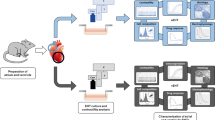Abstract
This chapter details the generation of atrial fibrin-based engineered heart tissue (EHT) in standard 24-well format as a 3D model for the human atrium. Compared to 2D cultivation, human-induced pluripotent stem cells (hiPSCs)-derived atrial cardiomyocytes demonstrated a higher degree of maturation in 3D format. Furthermore, we have demonstrated in previous work that the model displayed atrial characteristics in terms of contraction and gene expression patterns, electrophysiology, and pharmacological response. Here, we describe how to embed atrial cardiomyocytes differentiated from hiPSCs in a fibrin hydrogel to form atrial EHT attached to elastic silicone posts, allowing auxotonic contraction. In addition, we describe how force and other contractility parameters can be derived from these beating atrial EHTs by video-optical monitoring. The presented atrial EHT model is suitable to study chamber-specific mechanisms, drug effects and to serve for disease modeling.
Access this chapter
Tax calculation will be finalised at checkout
Purchases are for personal use only
Similar content being viewed by others
References
Kirchhof P, Benussi S, Kotecha D et al (2016) 2016 ESC Guidelines for the management of atrial fibrillation developed in collaboration with EACTS. Eur Heart J 37:2893–2962
Iwasaki YK, Nishida K, Kato T et al (2011) Atrial fibrillation pathophysiology: implications for management. Circulation 124:2264–2274
Devalla HD, Schwach V, Ford JW et al (2015) Atrial-like cardiomyocytes from human pluripotent stem cells are a robust preclinical model for assessing atrial-selective pharmacology. EMBO Mol Med 7:394–410
Milani-Nejad N, Janssen PML (2014) Small and large animal models in cardiac contraction research: advantages and disadvantages. Pharmacol Ther 141:235–249
Blazeski A, Zhu R, Hunter DW et al (2012) Cardiomyocytes derived from human induced pluripotent stem cells as models for normal and diseased cardiac electrophysiology and contractility. Prog Biophys Mol Biol 110:166–177
Ma J, Guo L, Fiene SJ et al (2011) High purity human-induced pluripotent stem cell-derived cardiomyocytes: electrophysiological properties of action potentials and ionic currents. Am J Physiol Circ Physiol 301:H2006–H2017
van den Berg CW, Elliott DA, Braam SR et al (2016) Differentiation of human pluripotent stem cells to cardiomyocytes under defined conditions. Methods Mol Biol 1353:163–180
Marczenke M, Piccini I, Mengarelli I et al (2017) Cardiac subtype-specific modeling of Kv1.5 ion channel deficiency using human pluripotent stem cells. Front Physiol 8:469
Lee JH, Protze SI, Laksman Z et al (2017) Human pluripotent stem cell-derived atrial and ventricular cardiomyocytes develop from distinct mesoderm populations. Cell Stem Cell 21:179–194.e4
Zhang Q, Jiang J, Han P et al (2011) Direct differentiation of atrial and ventricular myocytes from human embryonic stem cells by alternating retinoid signals. Cell Res 21:579–587
Zaffran S, Robrini N, Bertrand N (2014) Retinoids and cardiac development. J Dev Biol 2:50–71
Lemme M, Ulmer M, Lemoine MD et al (2018) Atrial-like engineered heart tissue: an in vitro model of the human atrium. Stem Cell Reports 11:1378–1390
Cyganek L, Tiburcy M, Sekeres K et al (2018) Deep phenotyping of human induced pluripotent stem cell–derived atrial and ventricular cardiomyocytes. J Clin Invest 3(12):e99941
Besser RR, Ishahak M, Mayo V et al (2018) Engineered microenvironments for maturation of stem cell derived cardiac myocytes. Theranostics 8:124–140
Weinberger F, Mannhardt I, Eschenhagen T (2017) Engineering cardiac muscle tissue. Circ Res 120:1487–1500
Kolanowski TJ, Antos CL, Guan K (2017) Making human cardiomyocytes up to date: derivation, maturation state and perspectives. Int J Cardiol 241:379–386
Schaaf S, Eder A, Vollert I et al (2014) Generation of strip-format fibrin-based engineered heart tissue (EHT). Methods Mol Biol 1181:121–129
Eder A, Vollert I, Hansen A et al (2016) Human engineered heart tissue as a model system for drug testing. Adv Drug Deliv Rev 96:214–224
Mannhardt I, Breckwoldt K, Letuffe-Brenière D et al (2015) Human engineered heart tissue: analysis of contractile force. Stem Cell Reports 7:29–42
Ulmer BM, Stoehr A, Schulze ML et al (2018) Contractile work contributes to maturation of energy metabolism in hiPSC-derived cardiomyocytes. Stem Cell Reports 10:834–847
Lemoine MD, Krause T, Koivumäki JT et al (2018) Human iPSC-derived engineered heart tissue as a sensitive test system for QT prolongation and arrhythmic triggers. Circ Arrhythmia Electrophysiol 11:e006035
Lemoine MD, Mannhardt I, Breckwoldt K et al (2017) Human iPSC-derived cardiomyocytes cultured in 3D engineered heart tissue show physiological upstroke velocity and sodium current density. Sci Rep 7:5464
Goldfracht I, Protze S, Shiti A et al (2020) Generating ring-shaped engineered heart tissues from ventricular and atrial human pluripotent stem cell-derived cardiomyocytes. Nat Commun 11:1–15
Lemme M, Braren I, Prondzynski M et al (2019) Chronic intermittent tachypacing by an optogenetic approach induces arrhythmia vulnerability in human engineered heart tissue. Cardiovasc Res 116(8):1487–1499
Lee MO, Jung KB, Jo SJ et al (2019) Modelling cardiac fibrosis using three-dimensional cardiac microtissues derived from human embryonic stem cells. J Biol Eng 13:1–17
Breckwoldt K, Letuffe-Brenière D, Mannhardt I et al (2017) Differentiation of cardiomyocytes and generation of human engineered heart tissue. Nat Protoc 12:1177
van Meer BJ, de Vries H, Firth KSA et al (2017) Small molecule absorption by PDMS in the context of drug response bioassays. Biochem Biophys Res Commun 482:323–328
Sala L, Van MBJ, Tertoolen LGJ et al (2018) Musclemotion: a versatile open software tool to quantify cardiomyocyte and cardiac muscle contraction in vitro and in vivo. Circ Res 122:e5–e16
Mannhardt I, Saleem U, Benzin A et al (2017) Automated contraction analysis of human engineered heart tissue for cardiac drug safety screening. J Vis Exp 2017:1–10
Author information
Authors and Affiliations
Corresponding author
Editor information
Editors and Affiliations
Rights and permissions
Copyright information
© 2022 Springer Science+Business Media, LLC, part of Springer Nature
About this protocol
Cite this protocol
Krause, J. et al. (2022). Human-Engineered Atrial Tissue for Studying Atrial Fibrillation. In: Coulombe, K.L., Black III, L.D. (eds) Cardiac Tissue Engineering. Methods in Molecular Biology, vol 2485. Humana, New York, NY. https://doi.org/10.1007/978-1-0716-2261-2_11
Download citation
DOI: https://doi.org/10.1007/978-1-0716-2261-2_11
Published:
Publisher Name: Humana, New York, NY
Print ISBN: 978-1-0716-2260-5
Online ISBN: 978-1-0716-2261-2
eBook Packages: Springer Protocols




